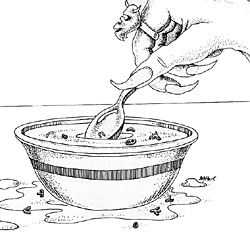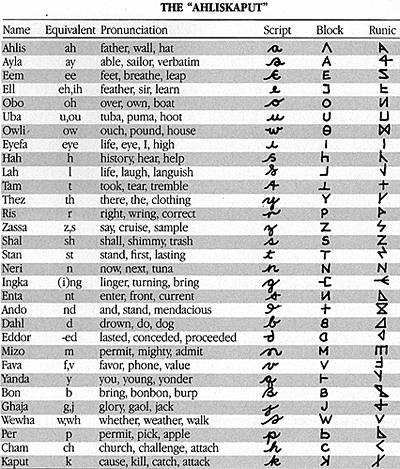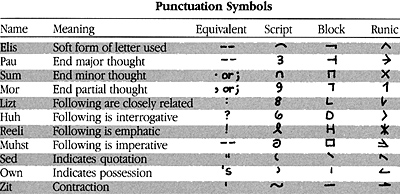 One way to emphasize a different culture to your players and their characters is to show them the difficulties of communication when two dissimilar cultures meet. It will be bard to talk to each other, unless a common language is known; even if speech can be solved, abstract concepts are not going to flow back and forth. The words will cover basic things like food Even a common language does not imply a common alphabet. The characters will probably be illiterates in some cultures. The following alphabet is offered as an example of giving the characters a feeling for a different culture. It's a visual aid for the Gamemaster and concrete evidence for the players.
One way to emphasize a different culture to your players and their characters is to show them the difficulties of communication when two dissimilar cultures meet. It will be bard to talk to each other, unless a common language is known; even if speech can be solved, abstract concepts are not going to flow back and forth. The words will cover basic things like food Even a common language does not imply a common alphabet. The characters will probably be illiterates in some cultures. The following alphabet is offered as an example of giving the characters a feeling for a different culture. It's a visual aid for the Gamemaster and concrete evidence for the players.
A message can be written in an alternate style alphabet called the "Ahliskaput" (from the names of its first and last letters). This phonetic alphabet may be used by Gamemasters (GMs) to give their players a challenge in figuring out various written messages. No longer need a situation occur where the GM says, "You find a scroll. it is written in Elvish." One of the players replies, I read Elvish! What does it say?" and the GM reads a translation of the message. Using the ahliskaput, the GM can hand whoever is able to read the particular language involved a copy of the message and let the players translate it for themselves.
The ahliskaput contains 31 phonetic symbols in each of three forms (script, block, and runic) which may be used to construct various messages; 11 punctuation symbols are also included for each form. It is suggested that GMs not mix forms in a given message; it should be all script, all block, or all runic to prevent confusion while players attempt to translate the wording.
It is also recommended that all spelling be phonetic; "damaged" would come out as "damaj(ed)," or "exciting" as "ekzyt(ng)." The parentheses indicate a special combination letter. A pronunciation key for each letter is included in the table of the ahliskaput, and, of course, the names for the letters themselves provide clues to the pronunciation of each letter since the first phoneme of the letter's name is that letter's correct pronunciation. There are a number of combination letters for very frequently used phoneme sounds in English. The ahliskaput is transliterative, not truly translatable. Punctuation marks for various types of thought completions or speech patterns will help divide messages into discrete portions. The punctuation used for thought completions is the most frequently used and defines three phases:
1. the end of a major thought cluster, a paragraph, for which the English language has no equivalent;
2. the end of a minor thought, a sentence, equivalent to a period or semicolon;
3. the end of a partial thought, a phrase, equivalent to a comma or, in some cases, a semicolon.
There are some additional forms of intrascriptic punctuation used, such as the indicator for a following list of closely related ideas or objects (equivalent to a colon), and the verbal symbol, which usually begins and ends any enscription of direct oral communication (equivalent to single or double quotes).
Some letters have both a hard and a soft sound, as in the g/j connection, w/wh, f/v, or z/s. The second letter is the soft form. A special symbol (the elis) placed above the particular letter is used to indicate the soft sound in a phoneme. Signs for the various modes of a communication, interrogative, emphatic, and imperative are usually placed at the beginning of the thought they modify. The possessive symbol is used alone: no "(e)s" symbol is added to the word, as the symbol itself infers the possessive "(e)s" and indicates possession of the nearest noun in either direction, but usually following. The contraction symbol is placed over, in the case of script and block, or between, in runic, the letters on either side of the contraction.
The translation of the original message, by the way, is "If you can read this message, you already understand this article."
Kerry Lloyd is the author of the Thieves' Guild role-playing system and vice president of Gamelords, Ltd.


Back to Table of Contents -- Game News #8
To Game News List of Issues
To MagWeb Master Magazine List
© Copyright 1985 by Dana Lombardy.
This article appears in MagWeb (Magazine Web) on the Internet World Wide Web.
Other military history articles and gaming articles are available at http://www.magweb.com